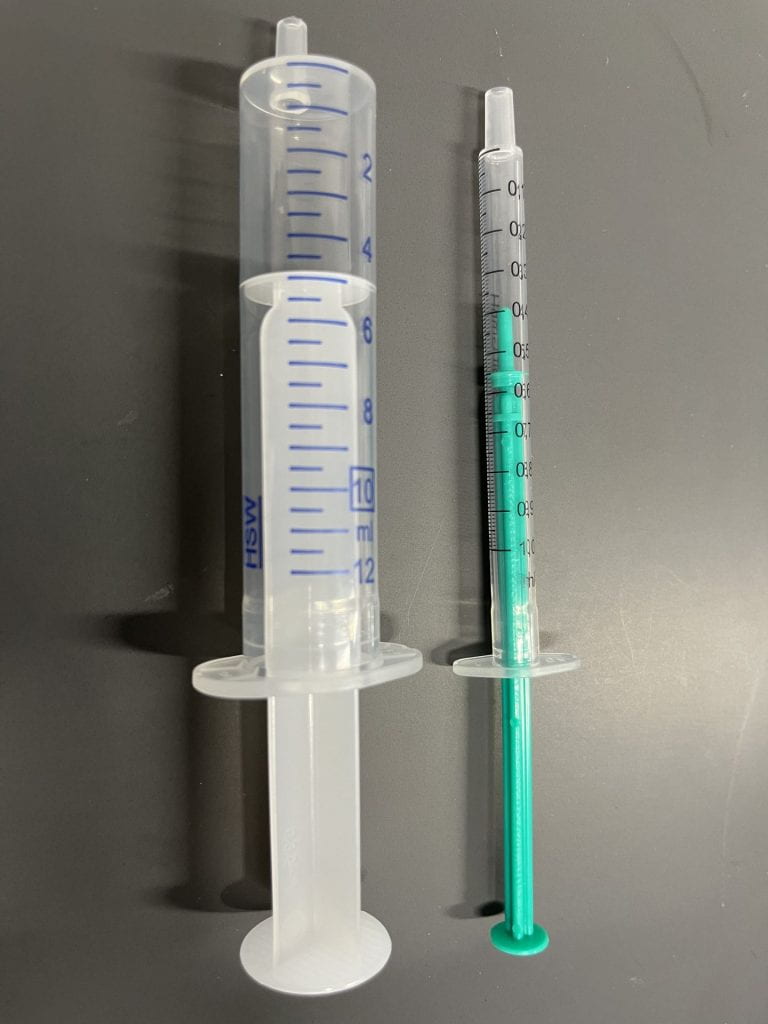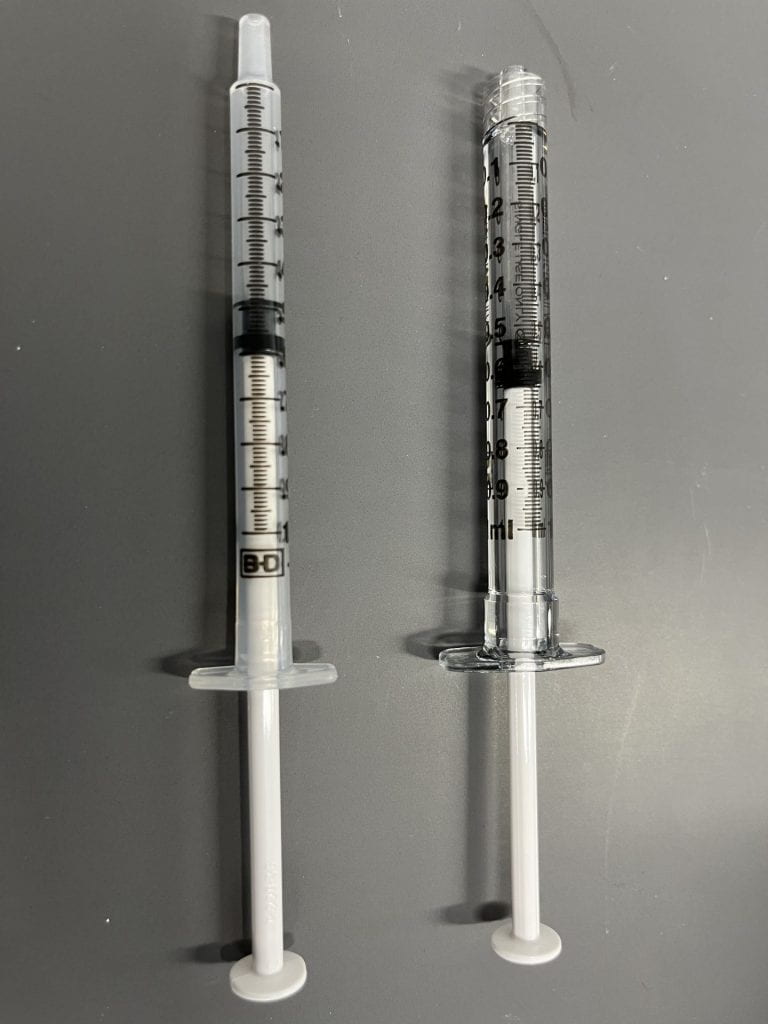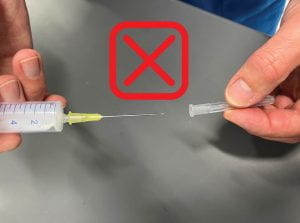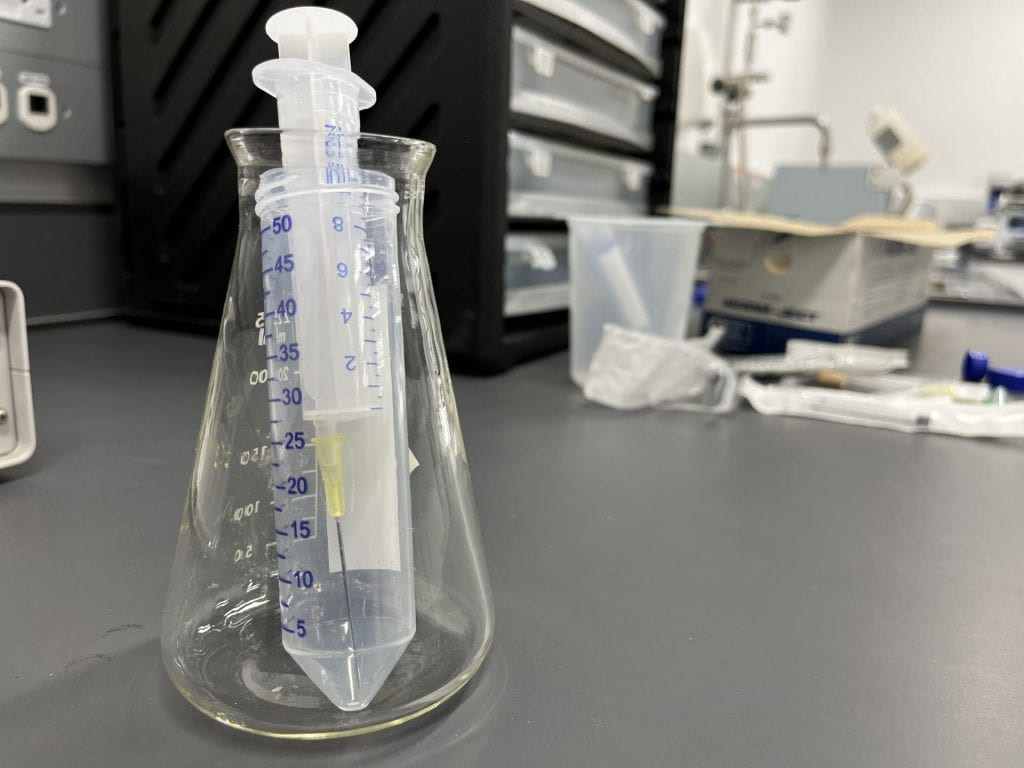Needles and syringes can be a high safety risk if handled improperly. Understanding the proper use, safe practices, disposal, and various needle and syringe options available to lab personnel are important to minimize the exposure to harmful hazardous chemicals in research laboratories. Avoid using needles if safe and effective alternatives are available.
- Needle and Syringe Options
- Syringe Fittings
- Selecting the Appropriate Needle
- Needle and Syringe Safe Practices
- Additional Safety Measures
For detailed information on needle and cannula selection, use, and safety, including illustrated instructions on air-free and pyrophoric handling techniques, see Safe Handling of Cannulas and Needles in Chemistry Laboratories.
Needle and Syringe Options
Types of Syringes
Disposable

Polyethylene barrel with a rubber-tipped plunger (usually black rubber)
- Pre-lubricated with silicone oil; may contaminate samples.
- Satisfactory for aqueous solutions.
- Very reliable seal
- Often used for medical practices
- NOT RECOMMENDED for organic solvents which often dissolve the oil and swell the rubber, causing the plunger to jam.
All polyethylene (NormJect®)
- Compatible with almost all chemicals.
- Lubricant-free; does not contaminate samples.
- Recommended for organic solvents.
- May swell if exposed to certain solvents (e.g., hexanes)
Reusable
Glass Syringes
Glass bodied syringes are available in two basic types. The first type mates a glass barrel with an accurately ground bore with a similarly accurately ground solid non-compliant plunger, which may be made from glass or stainless steel. In this type of syringe, there is no seal between the barrel and the plunger, rather liquid or gas escape is prevented merely by the barrel and plunger fitting together with extremely small clearance. The second type of glass syringe uses a barrel with a polished interior and a plunger with a compliant head (PTFE) which fits tightly by virtue of its elasticity.
- Stainless steel and glass plunger (liquid tight)
- Ideal for organic or aqueous samples that do NOT precipitate, crystalize, or react with glass.
- Do NOT use for strongly basic solutions (e.g. NaOH).
- Do NOT clean in a base bath.
- Stainless steel plungers should not be used for liquids that corrode stainless steel (e.g. HCl, Bromine solution).
- Unsuitable for very viscous liquids which may cause unusably stiff plunger movement
- Very sensitive to being jammed by dried deposits—requires diligent cleaning
- Plungers and syringes are accurately ground to fit each other.
- Plungers are not interchangeable. Attempting to swamp plungers between syringes may result in jamming or leakage.
- Plungers cannot be replaced if lost or damaged.
- These types of syringes should NEVER be used with pyrophoric liquids for the following reasons:
- The plunger has no restraint or detent to prevent it from being pulled completely out.
- Liquid can be pulled by capillary action between the plunger and the barrel.
- Most pyrophoric liquids easily generate deposits which will jam the syringe.
- Ideal for organic or aqueous samples that do NOT precipitate, crystalize, or react with glass.
- PTFE plunger (liquid and gastight)
- Metal or glass plunger with tight fighting PTFE piston on the end.
- Compatible with most liquids.
- Plungers are interchangeable and can be replaced.
- Disadvantage is that plunger movement may be very stiff, especially for larger sizes (≥10 ml).
Syringe Fittings
Most syringes and needles fit together using the Luer system, which consists of a standardized male taper on the syringe and a corresponding female taper on the needle. Although most commonly used on syringes and needles, these fittings are also available on cannulas, valves, and other accessories.
Luer Slip

- No locking mechanism.
- Quicker to fit (simple insert of needle into the syringe).
- Needles should be tightly pushed on with a twisting motion to ensure a secure fit.
- Relies on friction to keep needle in place.
- Oil or grease on the Luer tip may prevent the needle from staying in place.
- When used with a syringe filter under high pressure, extra care must be taken as the Luer joint may burst apart.
- Should not be used for extreme hazard materials such as pyrophorics.
Luer Lock
- An external screw thread engages with lugs on the needle to positively lock it in position.
- Provides greater resistance to needle detachment and higher safety.
- Suitable for use with pyrophoric materials.
- Recommended for use with syringe filters to reduce risk of joint bursting apart under pressure.
Selecting the Appropriate Needle
Hypodermic
Length
- The needle should be long enough to reach the liquid comfortably.If the needle is too short, this encourages the vessel to be awkwardly tipped, which may cause spillage.
- A long thin needle:
- Can cause excessive resistance to liquid flow, especially for viscous liquids.
- Increases the risk of accidentally pulling the plunger out of the barrel when withdrawing liquid.
- May fall off due to excessive pressure or cause liquid to leak between barrel and plunger.
- Avoid unnecessarily long needles as they are awkward to handle and buckle if thin.
Diameter
The external diameter of the needle is sized according to a standardized system of gauges. Smaller gauge numbers correspond to a larger diameter. The largest common diameter is 14 gauge. For short needles (≤ 2 in.), 16, 18, and 20 gauge are useful for general lab activities such as injecting liquids through septa. The thinnest needles for general use are around 24 gauge, although thinner needles are also available. Consider the following when selecting a needle diameter for an application:
- Appropriate gauge size depends on viscosity and hazard of the liquid.
- Thin needles can be hard to handle.
- A thin needle can easily bend or break when piercing a rubber septum. This can cause an increased risk of materials aerosolizing and leaking.
- Increased dead volume with smaller gauge size may cause difficulty when priming the syringe.
- Viscous samples may be difficult to extract.
- Slower withdrawal rates may be necessary to prevent over pressurizing of the syringe.
- A wide needle may cause damage to a rubber septum resulting in a clogged or defective needle.
Cannulas
A hollow, double ended needle.
- Used to safely transfer gases or liquids between two vessels.
- One end may be blunt while the other end pointed or both ends may be pointed.
- Material is usually stainless steel but PTFE is available for special purposes.
- Designed for transferring and handling of air-sensitive materials between reaction vessels.
- Various bore sizes and lengths are available depending on usage.
Safer Needle Devices
The most basic way to increase needle safety and avoid needlestick injuries is to use blunt ended needles whenever possible. Blunt-ended needles are not suitable for injecting liquid through rubber septa but they have numerous other uses including measuring liquid, transferring liquid between vessels, and applying adhesives.
Various kinds of safety needles are available as an engineering safety device to reduce the risk of needlestick injuries. They all work on the principal that after using the syringe and needle, the sharp point is protected either by some kind of cover or by the needle retracting into the syringe. Safety needles are a safe alternative to recapping of needles, which is normally prohibited as a hazardous activity. Safety needles are of particular utility in health care settings or when working with animals.
Examples of Safety Needles
- Blunt-Fill: A substitute for conventional needles.
- Self-sheathing : A shield that slides over the needle and locks in place.
- Retractable: Needle retracts into the syringe.
- Add-on Device: Hinged or sliding shield attached to needle.
- Eclipse Needles: An attached single-handed safety mechanism that locks over the needle.
Needle and Syringe Safe Practices

- Carefully assemble needle and syringe. NOTE: Use a Luer lock syringe where appropriate.
- Carefully remove the cap from the needle.
- Keep hands and body away from the sharp end of the needle and not in the “line of fire.” Ensure both hands are behind the plane of the needle.
- Extract the necessary volume by slowly pulling back the plunger. NOTE: Take extreme care not to withdraw the plunger too far if handling hazardous liquids (e.g., pyrophorics).
- When dispensing liquid, avoid excessive pressure on the plunger which may cause the needle to pop off.
- Dispose of the uncapped syringe and needle in the appropriate sharps waste container immediately following use.
- DO NOT re-cap needle – see Figure 3 and the Syringe Needle Disposal Safety safety flyer. Use a safety needle. Consult with EH&S (EHS@usc.edu) for approval if recapping needle is absolutely necessary.
- Syringes with a greater capacity than 10 ml shall NOT be used to handle pyrophorics.
- Large syringes are awkward and require excessive force to operate.
- It is extremely easy to accidentally pop out the plunger on a large syringe, causing burning pyrophoric liquid to spill onto the individual.
- Larger volumes of pyrophoric liquids should be measured by cannulating the material in and out of a measuring cylinder under an inert atmosphere.
Additional Safety Measures
- Keep needles away from fingers and other body parts.
- Unattended Needles and Storage – Needles and other sharps must not be left unattended. When not in use, sharps shall be stored in an appropriate secondary container – see Figure 4.
- Bleed needles can be kept safe by sticking them in a rubber/cork stopper (using one-handed technique) – see Figure 4.


- Syringe with attached needle can be placed upright in a plastic centrifuge tube in a rack, flask, or other suitable container – see Figure 5.
- Do not leave unprotected needles on any surface.
- Do not break or shear contaminated needles to avoid injuries and aerosol generation.
- Utilize locking syringe units, safety engineered sharps, or needless systems whenever possible.
- Never reuse disposable needles.
- Promptly report all needlestick injuries promptly to DPS @ (213) 740-4321 UPC or (323) 442-1000 HSC.
Rubber Septa
- Withdrawing liquid when nitrogen backfill is not required (e.g., pharmaceuticals, NOT pyrophorics or other air sensitive materials)
- Never have any body part in the direction of travel of the needle.
- Both hands should be behind the tip of the needle and the container should not be handled until the needle is fully inserted. Racks, clamps, or other means may be used as a form of stabilization.
- If it is necessary to invert the container to remove air bubbles, be extremely careful not to accidentally withdraw the needle from the septa.

- Withdrawing liquid when nitrogen backfill is required (e.g., pyrophorics)
- Always clamp the container.
- Ensure that an appropriate needle length is selected to be able to withdraw liquid and remove air bubbles from the syringe without moving the container.
- The container may be angled slightly – see Figure 7.

Syringe Filters
- Syringe filters are easy to over-pressurize and may pop off or burst. Several laboratory incidents have occurred in which this has caused a splash to the face.
- Syringe filters can easily fall off – see Figure 8. If the material is low in hazard, the syringe/filter can be gripped with a closed fist to help contain a splash in the event the filter detaches.
- Use Luer lock syringes to provide a more secure connection to the syringe filter.
- Parafilm or PTFE tape may be wrapped around the filter and syringe connection to secure the filter. This may not prevent filter detachment under excess pressure, but does reduce its likelihood and may prevent splashing – see Figure 8.

- If filtering particularly hazardous materials, it is recommended to utilize a significantly lowered fume hood sash as a splash guard (e.g., 12 inches and lower).
- If the filter becomes blocked, resist the temptation to apply excessive pressure.
- When using very small syringes (e.g., tuberculin style syringes), take extra care as it is very easy to over-pressurize a filter and have it burst or pop off the syringe. Remember: Pressure = force/area. The smaller the syringe diameter, the higher the pressure for a given force applied.